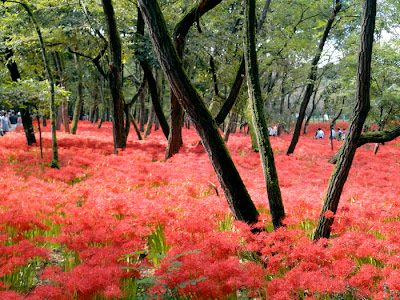October
Finally, last week I got to see the amazing red flowers, "higanbana" out at Kinchakuda, a park in Hidaka, Saitama. I'd been worried that the flowers would be decimated by several typhoons that came roaring up the coast last week, but they were still going strong. In fact, there were a lot of new buds, so I think the flowers will still look amazing this week.
Getting there is a bit of a chore. It really is easiest to go via the Seibu Ikebukuro line from Ikebukuro. Although I live in Saitama, it took several changes to finally get to Koma, the station nearest the park. I didn't need to worry about directions. There was a booth outside the station, decked out in red (higanbana red is "the" colour of Hidaka city), with free maps. But I just followed the genki oldies with their cameras. I swear, the over-60 crowd are singularly responsible for the continued welfare of Canon. The amount of expensive gear was amazing. About 85% of the crowd were probably retired, but there was a strange subset of Akihabara types - a few cosplayers, some gothic-cute kids and a guy taking pro-style shots of his doll. When I googled higanbana-themed animations, it seems "Higanbana no Saku Yoru ni", with ghosts and a lot of higanbana imagery, is very popular. But I could be wrong. Given the flower's association with graves (it blooms around "higan", when you visit ancestor's graves, so it often grows around graves) and tales of star crossed lovers, it really is quite a "goth" flower. And it's red. And it looks a bit like a spider.
It's an easy stroll from the station, and the route through little back lanes is lined with local stalls, selling home made jams, plants, chestnuts and branches of bright red things which I found out were "red eggplants". I didn't believe it at first, since they look like a tomato crossed with a chilli. But Google says they're real. I decided to leave the stalls till my return to the station, not wanting to carry an armload of autumn produce all over the park.
 |
| Red eggplants for sale. |
 |
| Just follow the crowds |
 |
| One of the local stalls |
 |
| These handy markers show you the way |
 |
| The approach to the park, through veggie patches. |
 |
| Scarecrows guarding the rice |
The air was heavy with the scent of kinmokusei (sweet osmanthus) which I love - it's a tiny orange flower, so well hidden in its trees and shrubs that you smell it but can't see it. It has a lovely sweet, sharp smell, not unlike freesia or daphne. Unfortunately, it was popular in the 80's as a toilet spray fragrance, so for a lot of Japanese of a certain age, it has those associations. I have the same feeling about hyacinths - a gorgeous flower with a really fresh, springtime scent, but when I was a kid, it was a popular, cheap smell in public toilets. I just can't wear the fragrance or smell the flowers without thinking "hmm... toilet".
 |
| This is a huge kinmokusei 'tree'. Intoxicating. |
The higanbana at Kinchakuda are like a red carpet under the trees, next to a river. People were enjoying picnics, painting, taking thousands of photos and - this being Japan - shopping! There was a rest area with food stalls and local craft stalls. I got sucked in to buying some local sake, after trying a few. oops.
 |
| Way too many photos of flowers coming up... |
 |
| Painting by the river |
 |
| Hello dolly |
 |
| Cosplayer |
 |
| The sake shop. |
On my way back to the station, I strolled through the cosmos field. It was lovely and wild. Cosmos tends to just range across the ground like a beautiful weed. People were gathering armfuls while red dragonflies darted around overhead. Perhaps it was all the flowers, or the unseasonably warm, yet comfortable weather, but everyone was in such a good mood. I completely forgot the hassle of getting there, and it felt a million miles from the concrete and crowds of Tokyo. Japanese friends often talk about the need for "green therapy" - getting out into the trees to refresh their senses. I think I understand, now.
 |
| Cosmos |
 |
| Blending in |
Kinchakuda costs a measly 200 yen (but if you're really cheap, you can look over the fence for free. The cosmos field is also free). The easiest way to get there is from Ikebukuro Station. Take the Seibu Ikebukuro express to Hanno station and change to a local train to Koma (you want to be going in the direction of Chichibu). It costs 510 yen each way and takes an hour. I went via Kawagoe and finished the afternoon with a stroll through the Kawagoe "koedo" historic area.
 |
| I was cajoled into buying an "autumn basket" from one of the local ladies, filled with cute little corn, a marrow of some kind, a chestnut still in its spiky cover, those red eggplants and some red chillies. She also threw in a few higanbana so, not a bad deal, really. |

























































